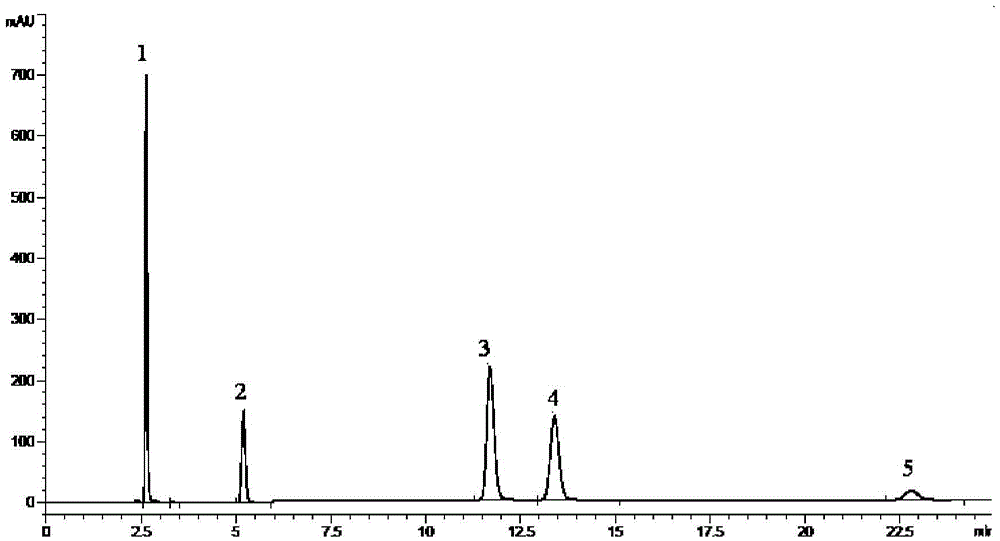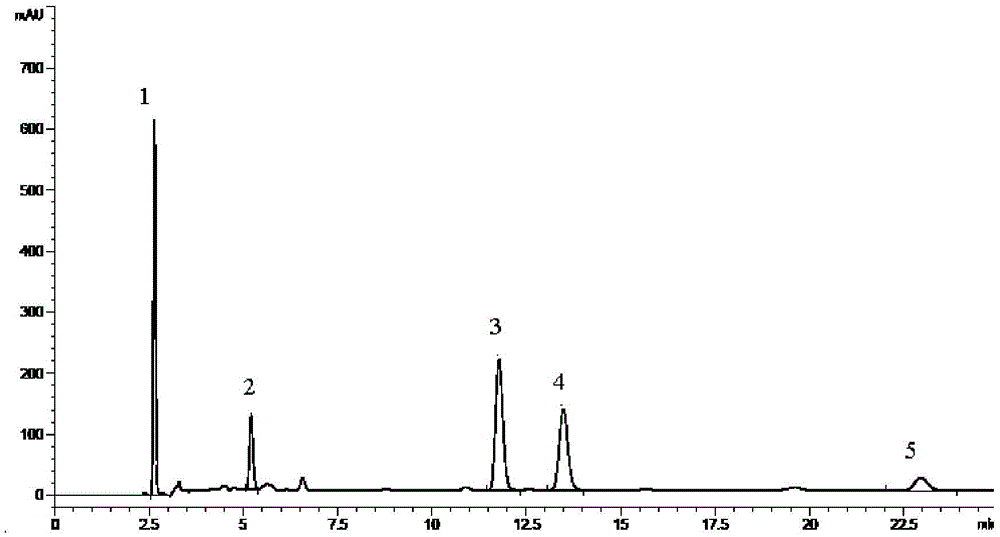Method for determining content of organic acid in ginkgo leaf extract
A determination method and extract technology are applied in the field of organic acid content determination in Ginkgo biloba extract, which can solve the problems of large polar span of proanthocyanidins and inability to completely remove interference, improve separation effect, facilitate balance, and accurately quantify organic acids. acid effect
- Summary
- Abstract
- Description
- Claims
- Application Information
AI Technical Summary
Problems solved by technology
Method used
Image
Examples
Embodiment 1
[0031] The impact of different purification methods of embodiment 1 on the determination of organic acids
[0032] Purification method 1: 100mg of Ginkgo biloba extract, 10ml of aqueous solution containing 1g / L bovine serum albumin, ultrasonically extracted at 50°C for 60min, filtered; the filtrate was adsorbed with HPD5000 macroporous resin, washed with water, eluted with 10% ethanol, collected and adsorbed The residue, the parts washed with water and the parts eluted with 10% ethanol were concentrated to dryness, and the residue was dissolved with 0.1% phosphoric acid, and the volume was adjusted to 10ml.
[0033] Purification method 2: extract 100 mg of ginkgo leaf extract with 10 ml of an aqueous solution with a pH value of 13, adjust the pH value of the extract to 1 with concentrated hydrochloric acid, and then extract twice with 100 ml of ethyl acetate. The two ethyl acetate solutions were combined, concentrated to dryness, and the residue was dissolved with 0.1% phospho...
Embodiment 2
[0037] Qualitative and quantitative of organic acid components in the Ginkgo biloba extract of embodiment 2
[0038] Take 100mg of ginkgo biloba extract, use 10ml of aqueous solution containing 1.0g / L bovine serum albumin, ultrasonically extract at 50°C for 1h, and filter; the filtrate is concentrated and dried to obtain an organic acid extract; The aqueous solution was dissolved and the volume was adjusted to 10ml, shaken up, filtered, and the subsequent filtrate was taken; the subsequent filtrate was determined according to the chromatographic conditions of Example 1.
[0039] The above method was validated by methodology, including instrument precision, repeatability, intermediate precision, linearity, sample recovery, and durability.
[0040] It was found that Ginkgo biloba extract contains shikimic acid, gallic acid, protocatechuic acid, 6-HKA, and p-hydroxybenzoic acid, but does not contain ferulic acid, chlorogenic acid, isochlorogenic acid A, and isochlorogenic acid B....
Embodiment 3
[0055] The investigation of embodiment 3 bovine serum albumin consumption
[0056] Take 100mg of ginkgo biloba extract, use 10ml of aqueous solution containing 0, 0.1, 0.3, 1.0, 3.0, 10g / L bovine serum albumin respectively, ultrasonically extract at 50°C for 1h, and filter; the filtrate is concentrated and dried to obtain an organic acid extract; The acid extract was dissolved with an aqueous solution containing 0.1% phosphoric acid and the volume was adjusted to 10ml, shaken up, filtered, and the subsequent filtrate was taken; the subsequent filtrate was determined according to the chromatographic conditions of Example 1.
[0057] see attached results figure 2 , attached Figure 5 And attached Figure 6 . attached figure 2 It is the chromatogram of the sample pretreated with 1.0g / L bovine serum albumin, and the 5 main peaks are in good shape without interference from other peaks. The chromatogram of the sample pretreated with 3.0 or 10g / L bovine serum albumin is attache...
PUM
 Login to View More
Login to View More Abstract
Description
Claims
Application Information
 Login to View More
Login to View More - R&D
- Intellectual Property
- Life Sciences
- Materials
- Tech Scout
- Unparalleled Data Quality
- Higher Quality Content
- 60% Fewer Hallucinations
Browse by: Latest US Patents, China's latest patents, Technical Efficacy Thesaurus, Application Domain, Technology Topic, Popular Technical Reports.
© 2025 PatSnap. All rights reserved.Legal|Privacy policy|Modern Slavery Act Transparency Statement|Sitemap|About US| Contact US: help@patsnap.com



